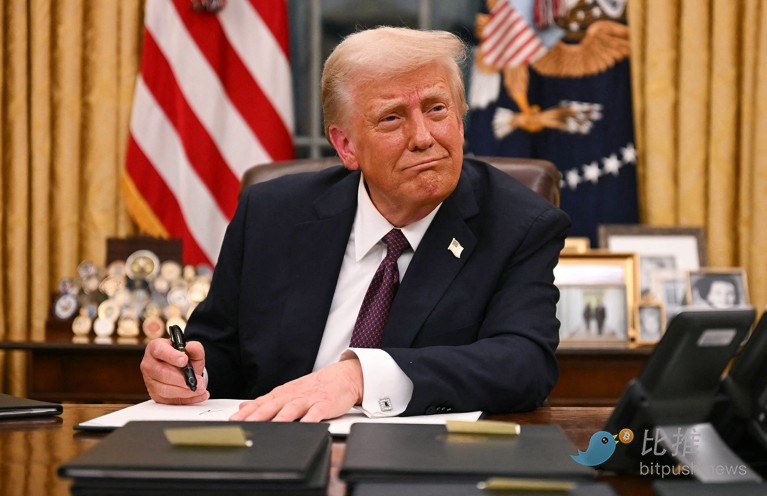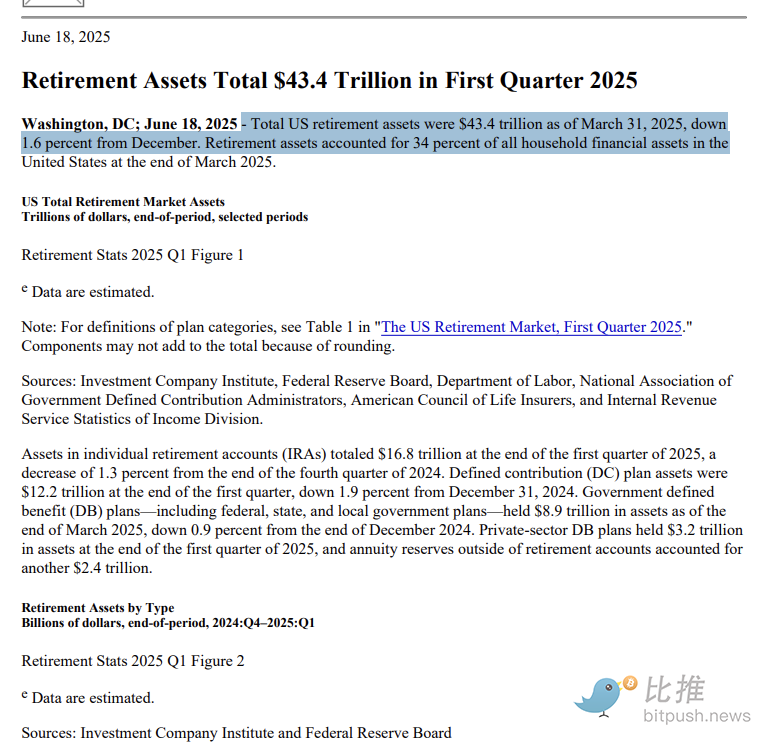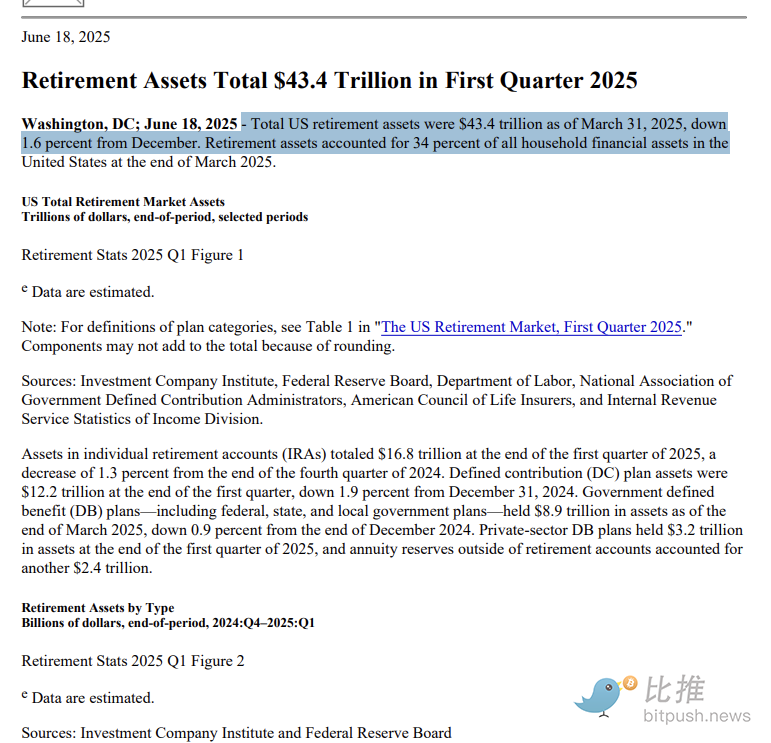Retiring on Crypto Becomes Reality! Trump Pulls All Americans Onto the Gambling Table

On August 7, 2025, a moment destined to make a profound mark on U.S. financial history quietly unfolded.
Donald Trump signed an executive order allowing 401(k) retirement savings accounts in the United States to formally invest in “alternative assets,” including cryptocurrencies, private equity, and real estate. With this move, an asset class once sidelined by the mainstream financial system was officially added to America’s nearly $9 trillion retirement plan universe.
This was not just a critical pivot in regulatory policy—it may well be the inflection point that finally brings digital assets into the financial mainstream.
From Fringe to Mainstream: The Power of a Single Executive Order
For decades, the 401(k) program—a retirement savings vehicle serving 90 million American workers—has been invested almost exclusively in traditional assets like stocks, bonds, and index funds such as S&P 500 ETFs. Alternative assets, cryptocurrencies in particular, have become increasingly prominent in the broader market, yet have remained out of reach for pension portfolios, with regulators historically taking a cautious or even hostile stance toward them.
But in 2025, everything began to change. Washington signaled a historic opening to digital assets, as the Trump administration aggressively championed deregulation—with crypto assets emerging as one of the primary beneficiaries of this new wave.
Trump’s executive order directed the Department of Labor to reevaluate relevant provisions in the Employee Retirement Income Security Act (ERISA), paving the way for including digital assets and private investments in 401(k) plans and giving regulators room to refine the rules along the way.
According to the Financial Times, Trump’s deep ties to the crypto industry played a substantial role: “If only private equity had been included, the order likely wouldn’t have advanced—crypto was the deciding factor for Trump.”
What Share? How Much Capital?
The numbers are striking—the U.S. 401(k) market is massive. As of the end of Q1 2025, employer-sponsored 401(k) plans held approximately $8.7 trillion in assets, while the broader U.S. retirement market (including 401(k)s, IRAs, and other vehicles) boasted $43.4 trillion in assets.

So how much could actually flow into crypto? There’s no definitive answer yet.
Tom Dunleavy, Venture Director at Varys Capital, offers a scenario:
“If every American’s 401(k) allocated just 1% of assets to cryptocurrency, that could mean a $120 billion inflow into the crypto market. At 3%, it would be $360 billion; at 5%, as much as $600 billion.”

This would represent a long-term, stable source of new capital: Most Americans automatically transfer part of every paycheck into their 401(k) every two weeks. Once digital assets are in the investment pool, this creates steady, passive buy-side flows.
For a market still defined by volatility, this is more than just capital—it helps anchor sentiment. “This will provide Bitcoin and Ethereum with stronger price stability ranges,” Dunleavy observes.
Bitwise Head of Research Ryan Rasmussen adds:
“In the short run, this executive order sends a message to the market: Crypto assets have moved from the margins to institutional acceptance.”
ETFs: The Ideal Bridge
Beyond direct allocation within 401(k) accounts, crypto ETFs stand out as the leading access channel.
By mid-2025, ETFs tracking bitcoin and ethereum had already attracted over $13 billion in net flows. BlackRock’s iShares Bitcoin Trust (IBIT) and VanEck’s Ethereum ETF (ETHV) posted year-to-date returns of 20% and 11%, respectively.
ETFs offer clear advantages:
- No need for a crypto wallet;
- No need to use decentralized exchanges;
- Issued by regulated asset managers;
- Easily integrated alongside traditional assets in a diversified portfolio.
Just as the GLD gold ETF is far more accessible than buying physical gold, ETFs are poised to become the gateway of choice for retirement savers seeking crypto exposure.
How Long Until It Takes Effect?
Trump’s executive order provides a powerful directional signal, but there’s a long road from “law on the books” to “crypto in your retirement account.” The push to add crypto to 401(k) plans sits squarely between policy intent and the practical realities of execution.
There are three main areas of complexity to consider:
Regulatory Hurdles
While the executive order sets a clear mandate, it does not immediately change the law. Instead, it instructs the Department of Labor (DoL), the Securities and Exchange Commission (SEC), and similar agencies to reexamine and revise the current regulatory framework.
As CNBC notes, 401(k) plans are governed by ERISA, which requires fiduciaries to adhere to the “prudent man rule” to maximize participant protection. The high volatility, illiquidity, and valuation opacity of crypto assets make them difficult to pass prudent investment tests. In 2022, after Fidelity launched a bitcoin investment option for 401(k)s, the Department of Labor quickly raised public concerns and scrutiny. And while the policy direction has shifted in 2025, detailed rules are still pending. Plan providers acting too quickly still face regulatory and legal risks.
Provider Concerns: Avoiding the “Scapegoat” Trap
Most 401(k) plans are administered jointly by employers and third-party providers such as Vanguard, Fidelity, and Empower. As of now, most major platforms remain highly cautious about crypto options.
The reasons include:
- High legal liability: If investors lose money, fund managers and employers could be sued for breach of fiduciary duty.
- Poor investor education: Most 401(k) participants have little understanding of crypto and could misjudge the risks.
- High technical integration costs: Adding a new asset class requires significant upgrades to risk management systems, reporting workflows, and KYC processes.
So, even if policy permits, most crypto allocations will initially rely on “Self-Directed Brokerage Windows,” a feature found only in certain large employers’ 401(k) plans and used by a small subset of financially savvy employees. As a mainstream option, regulated spot bitcoin and ethereum ETFs are the most likely vehicles, given their maturity and regulatory oversight.
Crypto Market Uncertainties Remain the Biggest Wild Card
Even with looser regulation and a willingness to push forward, it’s uncertain whether the crypto market is ready to absorb long-term capital flows effectively.
- Bitcoin and Ethereum have posted sharp recoveries this year, but both still see daily volatility exceeding 30%;
- Leveraged ETFs and on-chain derivative products continue to proliferate, raising risk for retail participants;
- The fallout from FTX and similar platform failures still hangs over the market, with investor trust in the process of being rebuilt;
- For many regulators, crypto remains unpredictable and lacks a stable yield profile.
As Teucrium Trading President Sal Gilbertie said on CNBC’s “ETF Edge”: “Leveraged crypto ETFs are aggressive products—not fit for retirement portfolios; they’re built for intraday trading.”
Sixteen Years: From the Edge to the Center
It took sixteen years to get from Satoshi Nakamoto mining the first bitcoin in 2009 to bitcoin’s inclusion in the U.S. pension system in 2025.
This journey, from margin to mainstream, was no accident—it resulted from the convergence of political motives, investor consensus, market dynamics, and technological progress.
One thing is clear: The Trump family and its inner circle have deep business interests in the crypto industry. Public disclosures show the family’s portfolio contains several billions of dollars in crypto and related businesses. The ascent of crypto—from fringe finance to mainstream adoption—reflects both a regulatory shift and an evolving debate on the link between power and capital.
Now, as cryptocurrencies become part of mainstream 401(k) retirement plans, their role is fundamentally changed—they’re no longer just speculative vehicles but are gaining status as a structural component of the U.S. financial system. Still, this transformation is only just beginning. Can crypto truly become a reliable option for retirement investing? For now, it must pass stern tests of market volatility, regulatory structure, and long-term value. Ultimately, this experiment is about more than returns; it could redefine the future architecture of finance.
Disclaimer:
- This article is republished from [bitpush], with copyright belonging to the original author [bitpush]. If you have any concerns regarding this republication, please contact the Gate Learn team, who will promptly address your request according to established procedures.
- Disclaimer: The views and opinions expressed in this article are solely those of the author and do not constitute investment advice of any kind.
- Other language versions of this article were translated by the Gate Learn team, and may not be copied, distributed, or plagiarized without referencing Gate.
Related Articles

Solana Need L2s And Appchains?

The Future of Cross-Chain Bridges: Full-Chain Interoperability Becomes Inevitable, Liquidity Bridges Will Decline

Sui: How are users leveraging its speed, security, & scalability?

Navigating the Zero Knowledge Landscape

What Is Ethereum 2.0? Understanding The Merge
